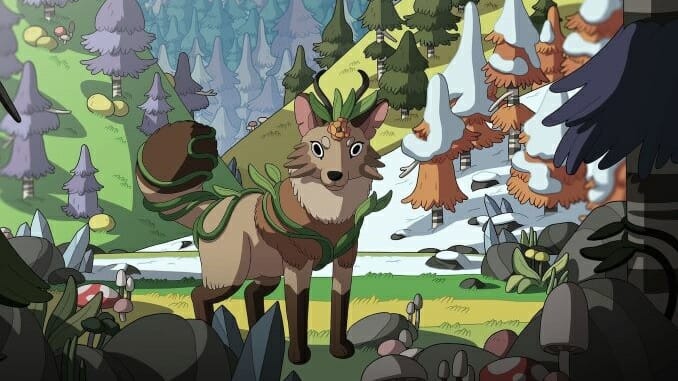
Brew is a strange … uh, mélange of game types, mashed up in a small box and fermented with some incredible art. Despite some strong individual aspects, though, this particular potion didn’t pan out for me.
Brew brings together elements of worker placement, area control, and resource management, along with a take-that aspect to the area control parts, although no single mechanic is very strong within the game. You’re fighting to control different cards that represent sections of the forest, which you can use to release animals you’ve caught and trained, all of which are worth points at game-end.
You do this via dice you roll at the start of each turn, four in your own color, two neutral white dice. On each turn, you’ll place one die on a space on the main board, gaining you resources or other actions; or on one of the forest cards, where the player with the most dice at the end of the round gets the card. (The white dice count as well, but as a neutral player, so you can also place them to try to prevent an opponent from gaining the majority.) You can use those resources to buy potion cards from the market, which then can allow you to alter dice, move them around once placed, or take other special actions. The game moves through four ‘seasons,’ flipping the main board each time to change the available actions, giving each player 24 main actions.

The spaces on the forest cards also give you some sort of immediate benefit. Some spaces let you take resources, while others let you “train” an animal from the table. You take the animal card, which is worth one point at game-end, and add it to your menagerie, which can hold up to 4 cards. They give you additional powers while they’re active, but to get the maximum three points for each at game-end, you need to retire them to a farm in upstate New York where they can run around all day … er, to a forest card of the matching color/terrain.
Ultimately, the forest cards carry the highest point values, but you can’t just throw all of your dice there, because other players can use various tricks to screw you over. If you roll a fire symbol, you can place that die on top of an opponent’s die to negate its value when determining who controls that forest card. You can use certain potions to move, swap, or remove placed dice from forest cards, your own dice or opponents’. There are also some powers that let you ‘scorch’ a forest space, rendering it unusable to any player for the remainder of the game. Those take-that elements will appeal more to some players than others, but with two players, it destabilizes the area control part of the game, and since that’s the biggest source of points, that makes the two-player experience unworkable.
Brew is thematically confused, and while I understand that’s partly the point of the theme, I think the problems with the theme spill over into the game play itself. In Brew, time has been broken within a magical forest, and players are supposed to help the forest heal itself by collecting ingredients for potions, enchanting the animals, and reestablishing the natural order of things. It’s not that clear which of those things is supposed to be most important, if at all, and that shows up in the game play—the potions that give the game its title are relatively unimportant in the game, allowing you to manipulate your dice in different ways, while the forest and animal cards are worth all of the points. The forest cards are the areas you’re trying to control with your dice, but they don’t have many spaces at all, so things like turn order come into play, and better luck on the dice rolls can give one player too much power. The game does have one rule tucked at the back of the rulebook that is easy to miss, where you can “force” a die—placing a die in a space that doesn’t match its symbol by spending a matching ingredient or wild token.
To be clear, I wanted to love Brew. It’s gorgeous, and the art is unique—I can’t think of another game that looks like this. (And thank goodness for that, because we do not need another forest-themed game where the animals look just like they do in every other forest-themed game.) There are clever elements here, but I think it’s unplayable at two players, and with more it’s still too unfocused for me.
Keith Law is the author of The Inside Game and Smart Baseball and a senior baseball writer for The Athletic. You can find his personal blog the dish, covering games, literature, and more, at meadowparty.com/blog.